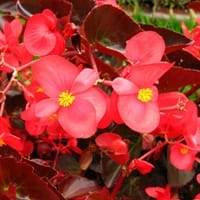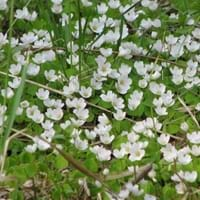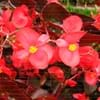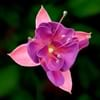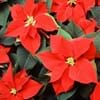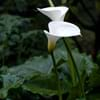Life Span
Perennial
Perennial
Type
Tender Perennial
Perennial
Origin
Hybrid origin
World, Pandemic, North America, Europe, United Kingdom, Asia
Types
'Bellagio Apricot' begonia, 'Bellagio Blush' begonia, 'Bellagio Pink' begonia
Not available
Number of Varieties
Not Available
Habitat
Subtropical climates, Tropical regions
Shaded sites, Woodlands
USDA Hardiness Zone
9-15
3-8
Sunset Zone
H1, H2, 14, 15, 16, 17, 18, 19, 20, 21, 22, 23, 24
A3, 1a, 1b, 2a, 2b, 3a, 3b, 4, 5, 6, 7, 8, 9, 10, 14, 15, 16, 17, 18, 19, 20, 21, 22, 23, 24
Habit
Upright/Erect
Mat-forming
Flower Color
Pink, Salmon
White, Light Pink
Flower Color Modifier
Not Available
Bicolor
Fruit Color
Tan
Not Available
Leaf Color in Spring
Red, Green
Light Green
Leaf Color in Summer
Red, Green, Dark Green, Bronze
Light Green
Leaf Color in Fall
Red, Dark Green, Bronze
Light Green
Leaf Color in Winter
Green
Light Green
Leaf Shape
Heart-shaped
Heart-shaped
Plant Season
Spring, Summer, Fall, Winter
Spring, Summer, Fall
Sunlight
Partial Sun, Partial shade
Partial Sun, Partial shade, Full Shade
Type of Soil
Loam, Sand
Clay, Loam, Sand
The pH of Soil
Acidic, Neutral
Neutral
Soil Drainage
Well drained
Average
Bloom Time
Indeterminate
Spring
Tolerances
Not Available
Shade areas
Where to Plant?
Container, Ground, Pot
Ground
How to Plant?
Seedlings, Transplanting
Divison, Seedlings
Plant Maintenance
Medium
Low
Watering Requirements
Over-watering can cause leaf problems or root diseases, Requires regular watering, Water Deeply
Water in the early morning hours
In Summer
Lots of watering
Lots of watering
In Spring
Moderate
Moderate
In Winter
Average Water
Average Water
Soil pH
Acidic, Neutral
Neutral
Soil Type
Loam, Sand
Clay, Loam, Sand
Soil Drainage Capacity
Well drained
Average
Sun Exposure
Partial Sun, Partial shade
Partial Sun, Partial shade, Full Shade
Pruning
Cut or pinch the stems, No pruning needed in the early stages, Prune if you want to improve plant shape, Prune to control growth, Remove dead or diseased plant parts
Remove damaged leaves, Remove dead branches, Remove dead flowers, Remove dead leaves
Fertilizers
All-Purpose Liquid Fertilizer
All-Purpose Liquid Fertilizer
Pests and Diseases
Aphids, Bacterial leaf spot, Botrytis Blight, Foliar nematode, Powdery mildew, Pythium rot, Rhizoctonia crown rot
Aphids, Root rot, Whiteflies
Plant Tolerance
Drought
Shade areas
Flower Petal Number
Single
Single
Foliage Texture
Medium
Medium
Foliage Sheen
Glossy
Matte
Attracts
Not Available
Insects
Allergy
Asthma
Asthma, Depression
Aesthetic Uses
Beautification
Not Used For Aesthetic Purpose
Beauty Benefits
Not Available
Good for skin, Not Available
Environmental Uses
Air purification
Air purification
Medicinal Uses
Bronchitis, Candidiasis, Cold, Digestive disorders, Dysentry, Haemoptysis, Liver problems, Menstrual Disorders, Scrofula, Swelling
Digestive, Eye Problems, Vitamin A, Vitamin C
Part of Plant Used
Whole plant
Flowers, Leaves
Other Uses
Used as Ornamental plant
Cleanser
Used As Indoor Plant
Yes
No
Used As Outdoor Plant
Yes
Yes
Garden Design
Container, Edging, Houseplant, Mixed Border, Tropical
Container, Mixed Border, Wildflower
Botanical Name
BEGONIA 'Richmondensis'
OXALIS acetosella
Common Name
Begonia, Richmond Begonia
wood sorrel, common wood sorrel
In Hindi
बिगोनिया
Wood Sorrel
In German
Begonie
Sauerklee
In French
Begonia
bois Sorrel
In Spanish
Begonia
alazán de madera
In Greek
μπιγκόνια
ξύλο Sorrel
In Portuguese
Begônia
Sorrel de madeira
In Polish
Begonia
Drewno szczaw
In Latin
Begonia
Rumex ligno
Phylum
Magnoliophyta
Magnoliophyta
Class
Magnoliopsida
Magnoliopsida
Order
Cucurbitales
Oxalidales
Family
Begoniaceae
Oxalidaceae
Clade
Angiosperms, Eudicots, Rosids
Angiosperms, Eudicots, Rosids
Tribe
Not Available
Not Available
Subfamily
Not Available
Not Available
Season and Care of Begonia and Wood Sorrel
Season and care of Begonia and Wood Sorrel is important to know. While considering everything about Begonia and Wood Sorrel Care, growing season is an essential factor. Begonia season is Spring, Summer, Fall and Winter and Wood Sorrel season is Spring, Summer, Fall and Winter. The type of soil for Begonia is Loam, Sand and for Wood Sorrel is Clay, Loam, Sand while the PH of soil for Begonia is Acidic, Neutral and for Wood Sorrel is Neutral.
Begonia and Wood Sorrel Physical Information
Begonia and Wood Sorrel physical information is very important for comparison. Begonia height is 30.50 cm and width 30.50 cm whereas Wood Sorrel height is 5.10 cm and width 30.00 cm. The color specification of Begonia and Wood Sorrel are as follows:
Begonia flower color: Pink and Salmon
Begonia leaf color: Red and Green
Wood Sorrel flower color: White and Light Pink
- Wood Sorrel leaf color: Light Green
Care of Begonia and Wood Sorrel
Care of Begonia and Wood Sorrel include pruning, fertilizers, watering etc. Begonia pruning is done Cut or pinch the stems, No pruning needed in the early stages, Prune if you want to improve plant shape, Prune to control growth and Remove dead or diseased plant parts and Wood Sorrel pruning is done Remove damaged leaves, Remove dead branches, Remove dead flowers and Remove dead leaves. In summer Begonia needs Lots of watering and in winter, it needs Average Water. Whereas, in summer Wood Sorrel needs Lots of watering and in winter, it needs Average Water.
